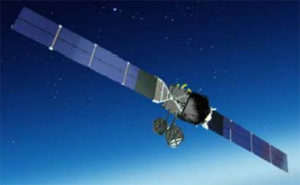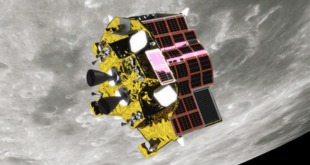
A Japanese military satellite payload, DSN-1, a dedicated military communications payload for the Japanese Ministry of Defence (MoD), was successfully launched into orbit on-board a SKY Perfect JSAT Superbird-8 communications satellite by Arianespace on 5 April 2018.
DSN-1/Superbird-8 is the 19th satellite launched by Arianespace for SKY Perfect JSAT. SKY Perfect JSAT is one of Asia’s leading satellite operators, with a major presence in the satellite broadcasting and telecommunications markets.
Superbird-8 will provide telecommunication services, primarily for the Japanese market, and will replace Superbird-B2, launched by Arianespace in 2000. Once in service, Superbird-8 will be renamed Superbird-B3.
After the successful launch, Stéphane Israël, Chief Executive Officer of Arianespace, said that, “Arianespace is very proud to serve our Japanese … customers with this third launch of 2018. We are very honored by SKY Perfect JSAT’s ongoing trust in us, since we have launched 19 of their satellites since 1989; and by the trust of the Japanese Ministry of Defense.”
DSN-1 is an X-band defence communications payload built by the DSN Corporation, a subsidiary of SKY Perfect JSAT, as part of a contract with Japan’s MoD. The Superbird8 satellite was built on a DS2000 bus by Mitsubishi Electric Corporation (MELCO) with NEC as prime contractor.
On the same day as the launch of the DSN-1/Superbird-8 communications satellite, Japanese newspaper The Yomiuri Shimbun reported that the Japanese MoD and Self-Defence Forces (SDF) are taking threats to Japanese satellites seriously, and are prioritizing defensive measures against possible counterspace measures.
As well as the DSN-1 military satellite communications payload, the Japanese government operates a fleet of Intelligence Gathering Satellites (IGS) – comprising a mix of high-resolution electro-optical and synthetic aperture radar reconnaissance satellites – for strategic early warning purposes. In addition, Japanese armed forces and national security establishment use the U.S. Global Positioning System (GPS) for military positioning, navigation, and timing (PNT) services, U.S. infrared ballistic missile early warning satellites, and commercial satellite services in Earth observation and communications.
“If the nation falls into a situation in which a satellite cannot be used, it will fatally impair the operations of the SDF and U.S. military,” a senior Japanese MoD official told The Yomiuri Shimbun.
In 2023, the Japanese government intends to have its space situational awareness (SSA) capability in operation that will be able to detect and monitor satellites and other objects in Earth orbit as they pass over Japan. The report also suggests that Japan is looking at some kind of responsive launch of spare satellites capability in the event that one of its satellites in orbit are destroyed. Lastly, The Yomiuri Shimbun also reports that the Japanese MoD is considering the creation of a space unit within the ministry, or one of the Self-Defence Forces.
New National Defence Programme Guidelines that are currently being drafted by Japan’s ruling Liberal Democratic party are believed to call the Ground, Maritime, and Air-Self Defence Forces to work closely together on national security space issues.





